- Policy
- Posted
Ghost estates
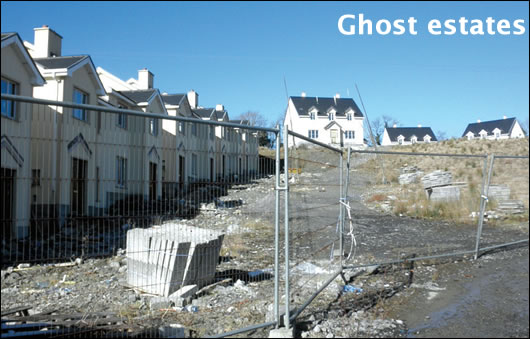
Due to the ill-considered productivity of the house building industry towards the tail end of the economic boom, Ireland is now saddled with hundreds of thousands of vacant homes in various states of completion. Structural engineer Sadhbh Ní Hógáin, currently writing her thesis for a masters architectural degree in advanced environmental and energy studies at the Centre for Alternative Technology, looks at the options Ireland has to address the problem.
Ghost Estate (noun): brand new housing estates (in Ireland) of more than 10 houses that are empty or have a vacancy or under-construction rate of 50 per cent or more, due to the housing market crash.
There are an estimated 621 ghost estates around the country, some 86 of which have more than 50 properties. About 253 estates comprise 21 – 50 units and a further 282 have between 10 and 20 homes, according to the National Institute for Regional and Spatial Analysis (Nirsa) in NUI Maynooth.
Therefore the property market in Ireland is currently characterised by an excess of supply, with a countrywide vacancy rate of about 16% of the housing stock, in excess of 300,000 homes (including holiday homes) estimated by Nirsa. Dr Brendan Williams of UCD has suggested that the proportion could be as high as 20%. This is over twice the European average of 7.3 per cent.
It is now apparent that recent development did not reflect market demands, but was driven by other factors. Tax incentives, irresponsible banking practice and sheer greed resulted in housing stock being built in areas where there was never the demand for the volume built. According to Nirsa director Professor Rob Kitchin: “Based on household growth, and accounting for obsolescence and potential holiday home demand, Leitrim would have needed around 1,035 houses over the period 2006 and 2009 but 2,945 were built and 1,324 were vacant in 2006 – above an expected base vacancy rate of 6% and excluding holiday homes. Many other counties have similar patterns of development.”
Building in Ireland has always been driven by economics and profit. However our most recent building stock was built with little regard to environmental concerns. Sustainability has been low on the agenda of most construction professionals. Considerations such as finite resources, the contribution of housing stock to carbon emissions and therefore to Irish commitments to the Kyoto agreement, were not included in planning or construction. To reach these emission targets that have been adopted by the Irish government a key area for reducing emissions is through the refurbishment of existing building stock. Due consideration must be given to reducing emissions via the housing stock during the recent housing boom of 2002 onwards.
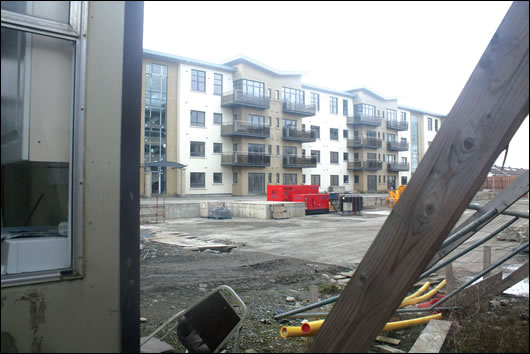
The presence of these ghost estates raises questions about what to do with them. A return to economic growth may see the demand for housing return quickly but this demand may be concentrated in the larger urban areas, such as Dublin, Cork and Galway. While many of these ghost estates lie in rural areas, population forecasts for recession times suggest outward rural migration to cities. Will the estates be fit for purpose if and when the market returns?
Among the options available for these ghost estates probably the two most relevant are refurbishment or demolition. The former would involve finishing any unfinished housing stock and upgrading other stock to a high standard of energy efficiency. The latter would entail the demolition of unoccupied estates and the return of sites to greenfield status.
In examining refurbishment versus demolition the wider picture of sustainability must be considered. This includes considering the social, economic and environmental benefits of both options. Social considerations include location of estates and the presence of local communities and local amenities. Economic considerations are the financial cost of each option, while environmental considerations include energy use, insulation, transport, materials and finite resources.
Refurbishment refers to any intervention to adjust, reuse or upgrade a building to suit new conditions and requirements . The drive for refurbishment of existing housing stock has primarily been economic thus far – in other words getting the job done as cheaply and efficiently as possible. However, with an increased awareness of global warming, one of the main benefits of refurbishing ghost estates lies in seizing the opportunity to reduce the use of finite resources such as fossil fuels. It also allows for an upgrade in the insulation of the building stock to be effected, which will minimise heat loss by improving energy efficiency.
The refurbishment of existing stock would include upgrading ghost estate stock to a low energy standard outlined in table one. To achieve these U-values, strategies such as applying external insulation to poorly insulated homes or improving the airtightness of the building envelope need to be considered.
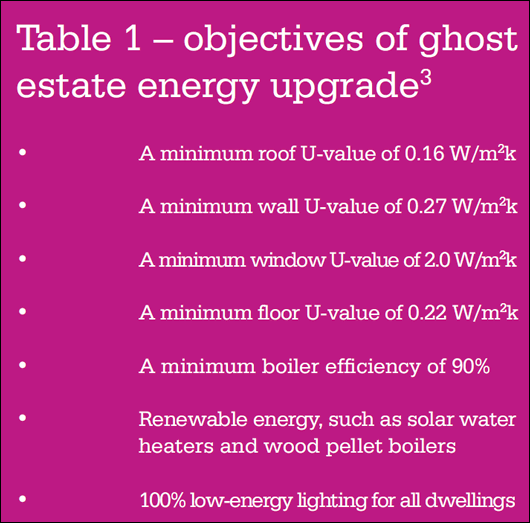
Refurbishment preserves the original structure of both the buildings and the surrounding area. Infrastructure such as roads, water mains and gas pipes can be maintained. Other benefits of refurbishment compared with demolition include local economic development, retention of community infrastructure, neighbourhood renewal and management. Refurbishment is socially more acceptable because it is less disruptive to individuals and communities. It has a lower environmental impact because buildings can be preserved.
Conversely, demolition involves the loss of buildings. The objective of the demolition of ghost estates would be to return them to green- field sites. However any demolition strategy would have to address the fate of the deconstructed materials. Throwing away construction materials is harmful to the environment. It wastes energy and materials, and is careless in the face of diminishing finite resources. The disposal of construction waste is covered under construction and demolition waste policy. However, this is not enforced strictly enough. Demolishing houses should go hand in hand with deconstruction whereby materials are salvaged and reused, within the bounds of practicability.
The demolition process has a high energy cost. This results from the embodied energy of materials, the disposal of demolished materials and the possible construction of new buildings, if required. Embodied energy is a measure of the quantity of non-renewable energy per unit of material.
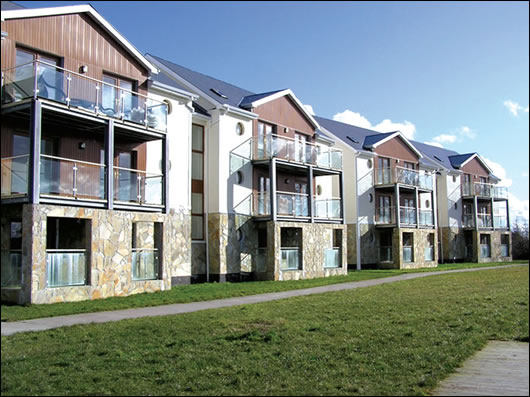
By demolishing, deconstructing and reusing the materials, the site can be returned to a greenfield site. Some materials can be salvaged for future use. However, the main benefit of demolishing these ghost estates lies in the opportunity it presents to address the issues of sustainable town and urban planning. The removal of ghost estates and a return to green field sites means planners have a “clean slate” to start sustainable urban and rural planning.
Sustainable communities are designed as places where people live and work, now and in the future. They are not built in locations where the owners/occupants have to commute long distances to and from their work. These communities meet the diverse needs of existing and future residents and are sensitive to the environment. They are well planned and built with good quality durable materials. For communities to be sustainable, they must offer local amenities such as schools, shops and public transport. They should provide a clean, safe environment in which to live.
A mixed-use development has many advantages, because rather than zoning for a single purpose, a mixed development can provide a range of benefits including fuel use, cost saving and quality of life.
Careful planning of the built environment can substantially reduce travel. Having schools, shops, businesses and homes all within walking or public transport distance requires integration at the town planning and development stages. These initiatives can save time, energy use and infrastructure requirements, as well as providing a better quality of life and a stronger sense of community. They will also contribute to a reduction in the country's carbon emissions.
The sustainable way forward is through a low carbon society. However, the question remains u how do we get there with what we have?
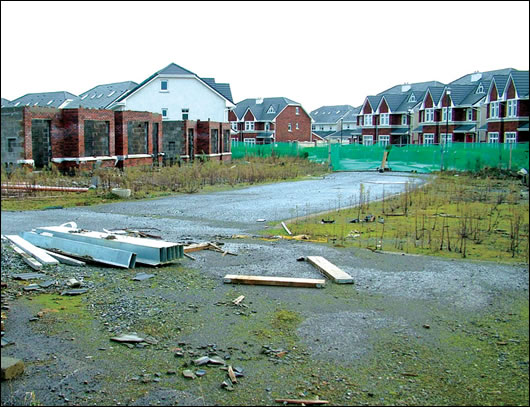
The refurbishment or demolition of the existing ghost estates would require all the estates to be evaluated in terms of state of completion, location, occupancy, local infrastructure and local employment. Based on this an assessment could be made of the relative benefits and drawbacks of refurbishment versus demolition. How best can ghost estates be turned into sustainable communities?
The main recommendation is that there needs to be a post-build cost benefit analysis of the existing estates. This involves an evaluation of the cost-effectiveness of different alternatives to see whether the benefits outweigh the costs. Such analysis should include an evaluation of the cost of demolition versus refurbishment, looking specifically at the financial cost of each option. However, further considerations need to be made for all the points outlined in table two. The points outlined include the social and environmental costs attached to each option. These include establishing whether the housing stock is within an existing community, and how viable the location is in terms of generating community. The analysis would also establish the quality and degree of completion of the housing stock. Quality would include the degree of insulation and the energy efficiency of the housing stock. Location would take into consideration the sustainability and practicality of continuing on the present site in terms of available infrastructure and employment. A review of the embodied energy and costs for the both options would also be required. Finally, feasibility studies of both options would be required to facilitate a decision for one or other option.
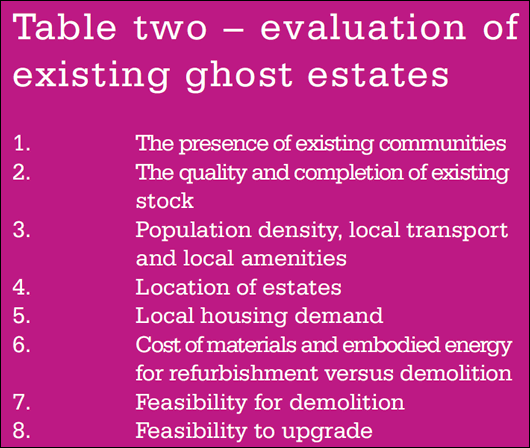
It is a difficult task to evaluate estates where roads are not completed, where there is no street lighting, and where construction rubble is lying around so that it's not safe for adults or children to be outside. Estates with good local facilities in mature areas should be completed and upgraded to a high energy standard. However, estates on the outskirts of towns, in commuting distance from local towns and with poor public transport should be examined for demolition or refurbishment.
Prior to evaluating these estates the points outlined in table two should be examined and graded in terms of importance. What do residents want and need in their local area? In a time of increased awareness of climate change, finite resources and the need for a return to self sufficiency, what are the most important measures for evaluating these ghost estates?
A blanket decision on refurbishment or demolition of these estates is difficult. Each estate needs to be evaluated on its own merits. Whatever approach is adopted – whether demolition or refurbishment – the most central consideration is that a substantially higher energy standard be achieved with reduced carbon emissions.
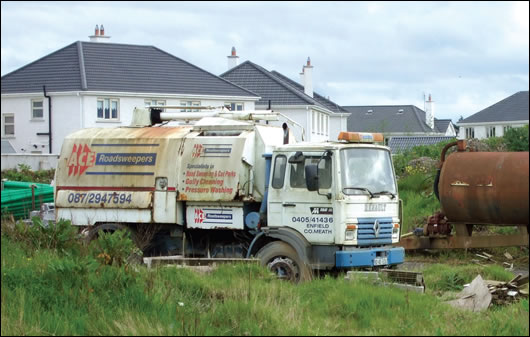
- Articles
- policy
- Ghost estates
- Vacant homes
- empty housing
- property boom
- Property Crash
- celtic tiger
- Estates
- NAMA
- Developers
- Economic Boom
- Housing Stock
Related items
-
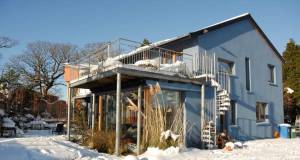 Out of the blue - a passive revolution
Out of the blue - a passive revolution -
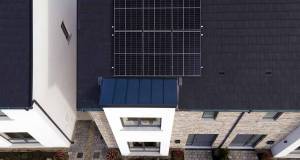 A grid of their own
A grid of their own -
Ireland joins whole life carbon data initiative
-
WorldGBC launches green building policy principles for governments
-
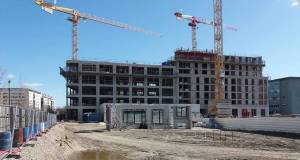 Housing for who?
Housing for who? -
 New passive house developer breaks ground in Bradford
New passive house developer breaks ground in Bradford -
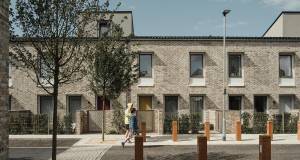 Stirling Work - The passive social housing scheme that won British architecture’s top award
Stirling Work - The passive social housing scheme that won British architecture’s top award -
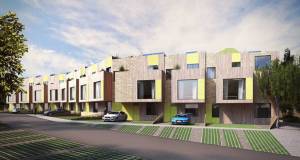 Durkan to break ground on 47 Killiney passive houses
Durkan to break ground on 47 Killiney passive houses -
 Cuckoos & magpies: state house-buying hits record
Cuckoos & magpies: state house-buying hits record -
 Blind & shutter group calls for Part B changes
Blind & shutter group calls for Part B changes -
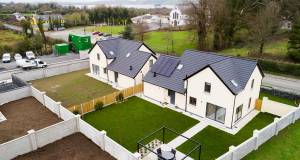 Westmeath NZEB scheme opens its doors
Westmeath NZEB scheme opens its doors -
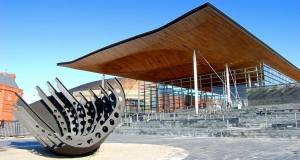 Wales votes to cut emissions 80%
Wales votes to cut emissions 80%

